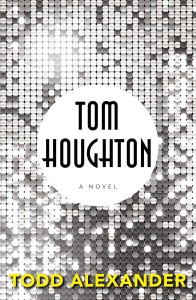Simon and Schuster
October 2015, RRP$32.99
 Growing up is hard, for everyone, no matter the circumstances. At least that’s the impression I have taken away, and taken comfort in, from the many creative expressions which delve into the experience of growing up and coming of age. This theme is also at the centre of Todd Alexander’s novel Tom Houghton.
Growing up is hard, for everyone, no matter the circumstances. At least that’s the impression I have taken away, and taken comfort in, from the many creative expressions which delve into the experience of growing up and coming of age. This theme is also at the centre of Todd Alexander’s novel Tom Houghton.
As with many novels tying together the transformative experiences of childhood and adulthood Tom Houghton moves between the past and the present. We meet Tom growing up in Sydney, with his mother Lana, a single mum who struggles with mental illness, and his traditional minded grandfather. And adult Tom, still living in Sydney, an actor whose personal life is scarred by years of self-centred and self-destructive behaviour.
Characters are clearly a strength in Alexander’s writing as the novel is populated by a plethora of fascinating individuals. The narrator and central character, Tom, is a prime example of this. The events of the novel moving between the past and present leave the reader alternately sympathetic and frustrated at his behaviour. The reader is sympathetic to the young Tom, struggling to fit in at school and understand his sexuality, however, he is capable of being both selfish and cruel. Adult Tom is a less sympathetic read, his behaviours are more self-destructive at heart but are unthinkingly damaging to those closest to him. And it is this flip flop between sympathy and irritation that makes this novel absorbing, if occasionally uncomfortable, reading.
The main thread—and the pivotal destructive and restorative element—that runs through Tom’s story is his perceived affinity with Tom Houghton Hepburn, the Hollywood actress Katherine Hepburn’s older brother. Hepburn died as a teenager in an apparent suicide, and this combined with the subsequent family silence, was a formative experience for Katherine. When our main character discovers that he shares the same birthday with Hepburn—and a tenuous potential relationship through the shared family name of Houghton—Tom comes to believe that it is his destiny to fulfill Hepburn’s potential which was cut so tragically short. And this belief incorporates itself so strongly into Tom’s sense of self-identity—in part as a coping mechanism when his teenage life becomes unbearable—that adult Tom is unable to separate himself from the imagined image of Hepburn.
Tom Houghton is a finely paced emotional journey of growing up and becoming yourself, two feats not necessarily achieved at the same point in life. It is not always a read in which you like the characters or their actions, nor is it a story in which all that has been done wrong is made amends for, but it does deliver an ultimately satisfying, and tentatively positive, ending.

